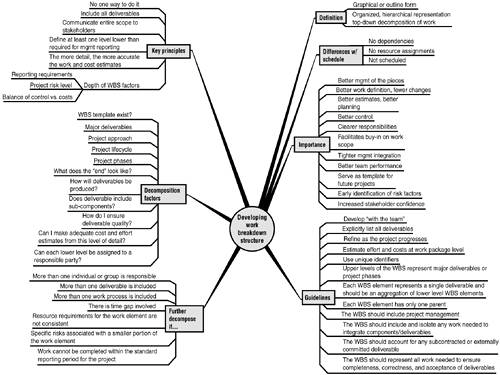The Process of Building a WBS
Now that we understand what a WBS is and the importance it plays to our project, let's review the key techniques, guidelines, and principles in building an effective WBS.
In general, the process of breaking down work is something we do frequently and is a straightforward logical endeavor. However, there are frequently two common challenges in the WBS development process.
- Where do I start?
- Where do I stop?
|
Major deliverables should come from the project definition document and are likely second-level WBS elements. There is no one way to organize a WBS. It should be organized in a manner that emphasizes the most important aspects and that best communicates the entire scope of the project to your stakeholders. |
Getting Started
To start the work decomposition process, think about the following:
- Does a template WBS exist as part of our methodology or from a past project that I can use?
- What are the major deliverables?
- What is the project approach? The project lifecycle? The major project phases?
- Think through the entire project. What does the "end" look like?
To continue the work decomposition process, think about these questions:
- Can I break down this WBS element (deliverable) into sub-components?
- How exactly will the deliverables be produced? What processes and methods will be used?
- How do I ensure acceptable quality in deliverables and in the process?
- Can I make adequate costs and duration estimates from this level of detail?
Guidelines for Effective WBS
Here are a few "guidelines" regarding the development of the project WBS that you will want to keep in mind:
- All the work of the project is included in the WBS.
- The WBS should be "deliverable focused."
- All deliverables are explicit in the WBS.
- The WBS should be developed "with the team."
- The WBS is refined as the project progresses.
- The WBS is a top-down decomposition and is logicalthe summary tasks go with lower level tasks.
- The WBS should be organized in a manner that emphasizes the most important aspects of the project and that best communicates the entire scope of the project to your stakeholders.
- The lowest level of the WBS is the work package or activity level and is used for schedule and cost development. This is the level where effort and cost can be reliably estimated.
- Unique identifiers are assigned to each item in the WBS to allow for better management reporting of costs and resources.
- WBS elements should be consistent with organizational and accounting structures.
- The coding scheme should clearly represent a hierarchical structure.
- Review and refine the WBS until all key project stakeholders are satisfied.
- Each WBS element represents a single deliverable and should be an aggregation of lower level WBS elements.
tip

WBS should always be defined at least one level lower than what is required for management reporting purposes. This allows you to better identify the source of any issues or variances.
- Each WBS element has only one parent.
- Upper levels of the WBS represent major deliverables or project phases.
- The WBS should include project management tasks and activities.

In general, the more detail in the WBS, the more accurate the work estimates and the better level of control. However, there is a balance. Too much detail and you will incur excessive costs performing data collection, tracking, and reporting. Too little detail and you incur higher risks and be unable to effectively manage.
- The WBS should include and isolate any work needed to integrate components/deliverables.
- The WBS should account for any subcontracted or externally committed deliverable.
- The WBS should represent all work needed to ensure completeness, correctness, and acceptance of deliverables.
- Depth of WBS depends on three key factors:
- The amount of project risk.
- The reporting requirements.
- The balance of control versus costs.
The level of depth (granularity) for the work package level in a WBS (lowest levels) will vary. It depends on what level of detail the project manager needs for effective management and control of the project.
In a program, or on large projects, the work package level may represent efforts in the hundreds of hours. In these cases, it is expected that the teams assigned to these work packages (or subprojects) will define the detail activities and tasks needed to complete the work package. From a practical standpoint, these teams should develop their own WBS that can then be rolled-up into the master WBS.
caution
|
Most troubled projects have WBS elements that are too large. If each lower level element should be completed within the standard reporting period (every week or every two weeks), it is much easier to track actual progress and to take any corrective actions. |
Knowing When to Stop
The other aspect of WBS development that creates frequent uncertainty is knowing when to stop. To determine if you have enough detail in your WBS, review these questions for each lower level item:
- Can each lower level item be estimated, scheduled, budgeted, and assigned to a responsible party?
- Do I need more detail to make it easier to estimate effort, assign work, track costs, or measure progress?

You will read about common rules of thumb for the proper size of work packages. The most common rules are 8/80 and 4/40, which means no task should be less than 8 hours or more than 80 hours, or in the case of 4/40, it would less than 4 hours or more than 40 hours.
These are solid guidelines, but not rules.
The most important thing to remember is to size the work package to the level you need for effective management and control. Again, setting the maximum size to correspond to your reporting period is an excellent idea.
- In addition, consider further decomposition of the lower level item, if any of the following are true:
- The work cannot be completed within the standard reporting period for the project.
- There are specific risks associated with a smaller portion of the work element.
- More than one individual or group is responsible.
- More than one deliverable is included.
- More than one work process is included.
- There is time gap involved.
- The resource requirements for the work element are not consistent.
The importance of the WBS cannot be over-emphasized. Since the correctness and completeness of the WBS has a direct impact on how well we determine our resource needs, estimate the work efforts, and properly sequence the work, it is the foundation that drives our schedule and most of our planning efforts.
Part i. Project Management Jumpstart
Project Management Overview
- Project Management Overview
- What Is Project Management…Exactly?
- What Is the Value of Project Management?
- Why Are Projects Challenging?
- Growing Demand for Effective Project Managers?
- Trends in Project Management
The Project Manager
- The Project Manager
- One Title, Many Roles
- Key Skills of Project Managers
- Qualities of Successful Project Managers
- 15 Common Mistakes of Project Managers
Essential Elements for any Successful Project
- Essential Elements for any Successful Project
- What Exactly Is a "Successful" Project?
- Learning from Troubled Projects
- Learning from Successful Projects
- Essential Project Manager Toolkit
Part ii. Project Planning
Defining a Project
- Defining a Project
- Setting the Stage for Success
- How Does Defining a Project Relate to Project Planning?
- Project Definition Document
- Project Definition Checklist
Planning a Project
- Planning a Project
- Key Project Planning Principles
- Important Questions Project Planning Should Answer
- Building a Project Plan
- Summary of Supplemental Project Plan Components
- Project Plan Checklist
Developing the Work Breakdown Structure
- Developing the Work Breakdown Structure
- What Is a WBS Exactly?
- Why Is the WBS Important?
- The Process of Building a WBS
Estimating the Work
- Estimating the Work
- Next Step in the Schedule Development Process
- Managing the Risk, Managing the Estimates
- Reasons for Estimating Woes
- Powerful Estimating Techniques and Methods
- Best Practices
Developing the Project Schedule
- Developing the Project Schedule
- The Impact of the Project Schedule
- The Goal of the Schedule Development Process
- Key Inputs for Building a Schedule
- Creating a Schedule
Determining the Project Budget
- Determining the Project Budget
- The Impact of the Project Budget
- Principles of an Effective Budget
- Creating a Project Budget
- Common Budget Challenges
Part iii. Project Control
Controlling a Project
- Controlling a Project
- What Is Project Control?
- Management Fundamentals for Project Control
- Powerful Techniques for Project Control
- Performance Reporting
- Variance Responses
- Leveraging Earned Value Management Concepts
- Common Project Control Challenges
- Lessons from Project Recoveries
Managing Project Changes
- Managing Project Changes
- What Exactly Is a Project Change and Whats the Big Deal Anyway?
- Fundamentals for Managing Project Change
- What Causes Unplanned Scope Changes?
- Essential Elements of a Project Change Control System
- Powerful Techniques for Minimizing Project Changes
- Common Project Change Control Challenges
Managing Project Deliverables
- Managing Project Deliverables
- "Managing Project Deliverables" Means What Exactly?
- Why Do This? Its Too Much Work
- Identify, Protect, and Track: The Principles of Managing Work Products
- Best Practices
- Configuration Management Plan
- Common Challenges and Pitfalls
Managing Project Issues
- Managing Project Issues
- The Goals, Objectives, and Principles of Project Issue Management
- Key Features of Issue Management System
- Options for Issue Log
- Best Practices
- Some Special Situations
Managing Project Risks
- Managing Project Risks
- Key Risk Management Principles
- The Essential Process for Managing Project Risks
- The Common Sources of Project Risk
- Typical Problems
- Powerful Risk Control Strategies
- Are You Sure Its a Risk?
Managing Project Quality
- Managing Project Quality
- What Is "Project Quality"?
- Unique Aspects of Managing Project Quality
- Principles of Managing Project Quality
- Powerful Tools and Techniques for Project Quality
- Powerful Quality Strategies
- Typical Quality-Related Challenges
Part iv. Project Execution
Leading a Project
- Leading a Project
- More Than Managing
- Where Is Leadership Needed on a Project?
- Twelve Keys to Better Project Leadership
- Power of Servant Leadership Approach
Managing Project Communications
- Managing Project Communications
- What Are Project Communications?
- The Importance of Project Communications
- Why Communicating Can Be Tough
- Seven Powerful Principles
- Best Practices of Effective Project Communicators
Managing Expectations
- Managing Expectations
- Value of Reviewing Stakeholder Expectation Management
- Critical Aspects of Expectations
- Seven Master Principles of Expectation Management
- Essential Elements of Managing Expectations
Keys to Better Project Team Performance
- Keys to Better Project Team Performance
- High-Performing Teams
- Ten Key Principles
- Proven Techniques
- Special Situations
Managing Differences
- Managing Differences
- Five Key Principles
- Proven Techniques for Leading Cross-Functional Projects
- Proven Techniques for Leading Cross-Cultural Projects
- Proven Techniques for Leading Virtual Projects
Managing Vendors
- Managing Vendors
- First, Lets Clarify a Few Terms
- Ten Proven Principles of Vendor Management
- Twelve Tips for Buyers
- Seven Tips for Sellers
- Twelve Key Project Management Skills for Better Vendor Management
- Stuff You Need to Know About Contracts
Ending a Project
EAN: N/A
Pages: 169

